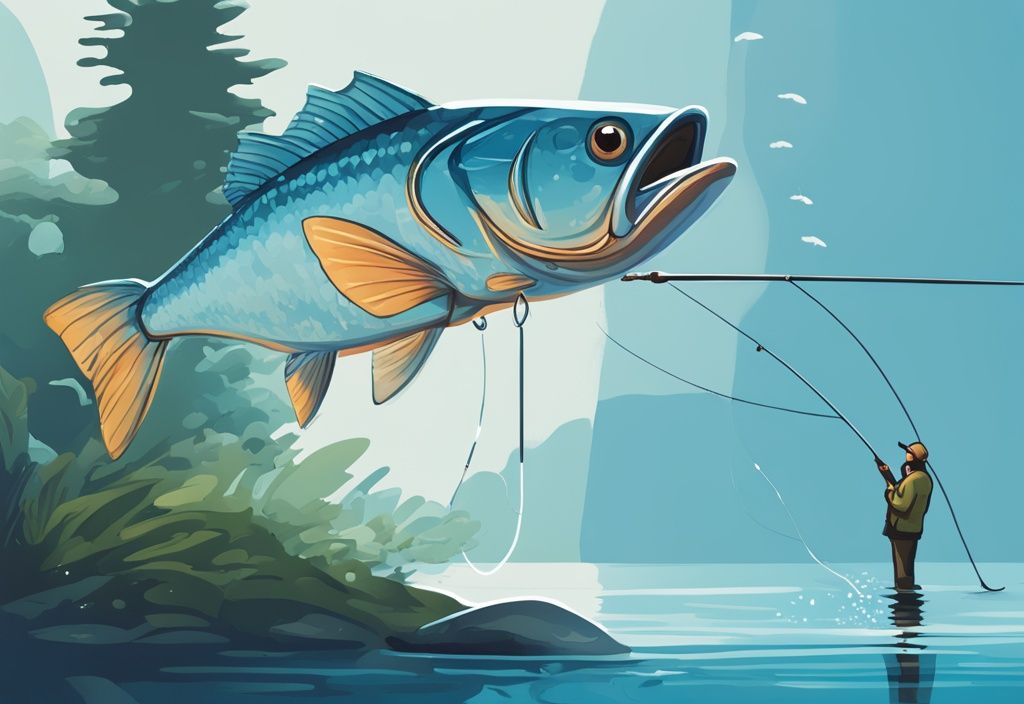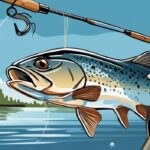Ever wondered how vital a tiny piece of line could be in scoring a big catch? That’s your fishing leader, my friend. This little champ does more than just connect your line to the lure; it’s a game-changer in the angling world.
Used correctly, a fishing leader can protect your line from the gnarly jaws of a prize pike or the rugged undersea structures where the sneaky snook likes to hide. But the tricks don’t stop there. The right leader also offers stealth to trick wary fish and flexibility that can give your bait an irresistible dance.
Stick around to find out exactly what a fishing leader is all about and how choosing the right one can take your fishing adventures from beginner luck to seasoned angling success.
Defining a Fishing Leader: Purpose and Key Benefits
Basics and Uses of a Fishing Leader
A fishing leader, my friends, is that essential line you wouldn’t want to hit the water without. It’s that trusty piece at the end of your main line, adding an extra layer of resilience that every seasoned angler appreciates. Imagine the wear and tear your line undergoes—this little hero steps in to offer extra abrasion resistance, ensuring your setup doesn’t fail you when it counts.
Not only that, but it also brings varying stiffness to the table. Picture casting your bait or lure; the right stiffness can make it dance just right, luring in those finicky fish. And don’t get me started on its low visibility—perfect for those crystal-clear waters where fish are smart and skittish.
Why Use a Fishing Leader: Advantages
Now, let’s talk about the fantastic advantages of using a fishing leader. Top of the list is protection—think structures, fish teeth, and all the contacts that could otherwise nick or cut your main line. This protection keeps your main line intact, reducing the heartache of losing a prized catch.
Another perk is the flexibility it affords in line choice. By using a fishing leader, you can opt for thinner or braided main lines. This not only amps up your spool capacity but also gives you better casting distance. The result? More time fishing and fewer hassles. Consider the fishing leader as that crucial link, the one entity standing between you and that awe-filling, line-tugging moment.
Typical Setups with Fishing Leaders
Every fishing scenario calls for its own unique leader configuration. Let’s stroll through some standard setups that’ll give you the edge.
Fluorocarbon rigs, for instance, shine in bottom fishing owing to their impressive abrasion resistance and low visibility. Ideal when you’re eyeing those bottom dwellers.
Then there are wire leaders, the go-to when targeting toothy critters like bluefish—no more losing lines to those sharp chompers. For those after cod, long monofilament topshots are a favorite. They offer the strength and abrasion resistance needed for these robust fighters. Each setup, tailored to specific environments and species, clearly highlights the versatility of fishing leaders. Picking the right one is key to tackling the waters with confidence.
Selecting Your Fishing Leader
Key Factors to Consider
When it comes to understanding what is a fishing leader, choosing the right one can make or break your fishing adventure. Think about this: you’re out there targeting that elusive trout in crystal-clear water, and your leader is spooking them away. Not fun, right?
Your decision should balance several key factors like the targeted species, fishing conditions, and your own preferences. Abrasion resistance is big, particularly if you’re navigating through rocky or coral-heavy waters. Visibility? Absolutely crucial! In clear water, fish can easily spot your line, so you need something less noticeable. Then there’s flexibility, which helps in presenting your bait naturally. Picture this—strike the perfect balance, and your fishing leader will enhance your angling prowess.
Understanding Leader Strength and Length
Tackling the right strength and length for your fishing leader is like matching your wits against the fish. Rule of thumb: aim for a leader that’s twice the length of your rod as a starting point. But remember, this can shift based on your fishing style and the type of fish you’re after.
Leader strength? Now that’s a game of chess. You’ll need something tough for those big, brutish fighters in harsh conditions. Made for different battlefields and warriors, your choice should mirror the size and fight in your target. Using a heavy-duty leader for a small pond bluegill might be entertaining but a tad overkill, don’t you think?
Choosing the Suitable Leader Material
Alright, material time! The substance of your fishing leader—monofilament, fluorocarbon, or wire—depends heavily on your fishing playground. Monofilament, with its flexibility and buoyancy, is your top dog for topwater fishing. Imagine it dancing on the water’s surface.
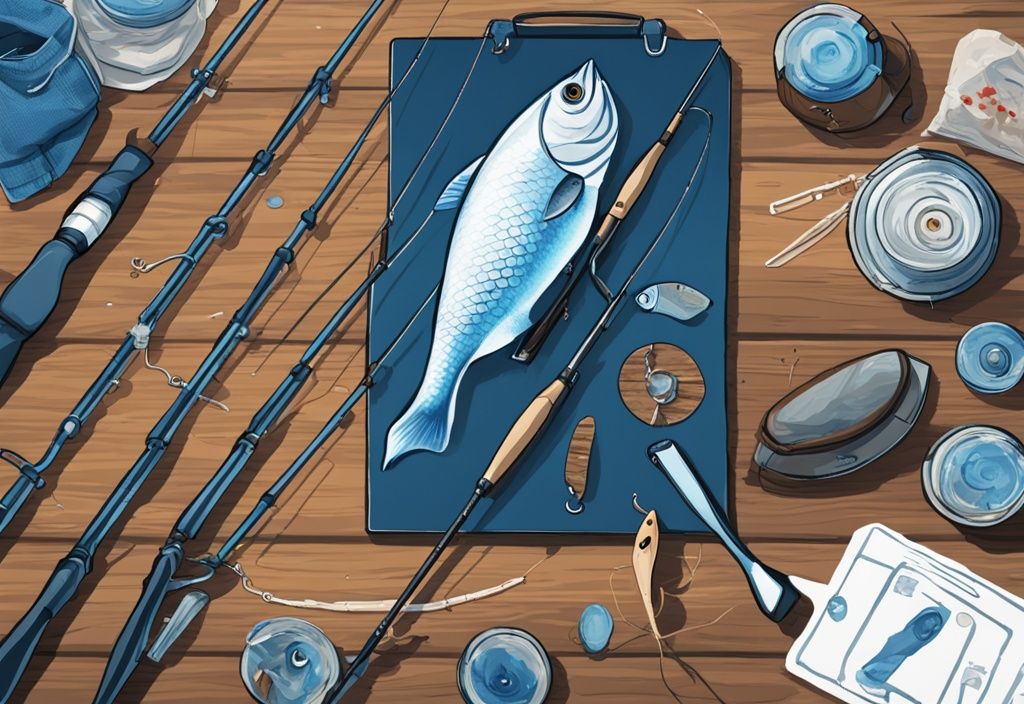
Fluorocarbon, on the other hand, is the stealth bomber of fishing. Nearly invisible underwater, it’s perfect for clear waters and around structures where visibility is critical. And we can’t forget wire leaders, superheroes when you’re dealing with toothy predators like mackerel and bluefish. These are your go-to for preventing those frustrating bite-offs.
Importance of the Fishing Environment & Species
Raise your hand if you’ve ever wondered why your fancy new leader isn’t delivering. The answer lies in the fishing environment and the specific species you’re targeting. Clear waters are unforgiving—opt for low-visibility leaders like fluorocarbon to stay out of the fish’s line of sight.
Fishing near structures? You’ll want abrasion-resistant leaders to withstand the wear and tear. And if you’re going after the big-toothed beasts like pike or barracuda, wire leaders are non-negotiable. Picture yourself losing a prize catch to shredded line—no thanks! By matching your leader type to your environment and the species you’re chasing, you’re one step closer to that triumphant catch moment.
Types of Fishing Leader Materials
Anglers know that choosing the right leader material can make or break a day on the water. The types of leader materials available are designed to meet specific needs, depending on the species targeted and the fishing environment. Let’s dive into the unique properties and applications of these materials.
Nylon Monofilament: Properties and Applications
Nylon monofilament is a versatile and commonly used leader material favored by many anglers. Its primary advantages are its affordability and ease of tying, making it an excellent choice for both novice and seasoned fishers. One of its standout features is low visibility, crucial when fishing in clear waters where fish are easily spooked.
While it offers moderate abrasion resistance, it excels in scenarios where you need a material that floats and provides substantial stretch and shock absorption. Clear monofilament is softer and more flexible, enhancing lure action and making it particularly effective for topwater lures and floating lines. Conversely, white or milky monofilament is stiffer and offers better abrasion resistance. It’s ideal for deep fishing and tackling species with raspy teeth, providing a robust yet effective solution for diverse fishing environments.
Fluorocarbon: Exploring its Features and Uses
Fluorocarbon leaders are crafted from multiple layers of fluoropolymer PVDF, making them denser and more durable compared to standard monofilament. These leaders sink due to their higher density, which can be advantageous when you need to reach deeper waters quickly. Additionally, fluorocarbon has a thinner diameter for the same breaking strength, providing an edge in terms of stealth and sensitivity.
Because fluorocarbon is more translucent, it offers superior low visibility underwater, making it ideal for presenting lures in a stealthy manner. This material exhibits excellent abrasion resistance, suitable for using diving lures, soft plastics, and fishing around structures where line wear is a concern. However, it’s worth noting that fluorocarbon is not the best choice for topwater lures, as it sinks rather than floats. Moreover, knot tying can be more challenging with fluorocarbon due to its stiffness, and it provides less stretch and shock absorption compared to monofilament.
Wire: Characteristics and Ideal Scenarios
Wire leaders are indispensable when targeting toothy species like Mackerel and bluefish. These leaders are generally made from single strands, which help prevent them from being cut by sharp teeth, ensuring that your main line remains intact even when dealing with more aggressive predators.
Thin and shorter wire leaders are preferred to minimize their visibility and impact on bite rates. They maintain strength without adding bulk, allowing for effective presentations despite the necessary ruggedness. This makes wire an excellent choice in situations where encountering fish that can easily sever traditional line materials is likely, ensuring you stay connected to your prized catch.
How to Connect Your Fishing Leader to the Main Line
When you’re out on the water, the way your fishing leader connects to the main line can make or break your fishing experience. From the right knots to the perfect swivels and leader clips, nailing this connection is like finding the sweet spot in a cast. Let’s dive into some tried-and-true methods that’ll help ensure a seamless setup.
Employing Knots for Attachment
Attaching a fishing leader to the main line can be accomplished efficiently using various fishing knots, ensuring a secure and seamless connection. One of the most popular and reliable methods is the Albright knot. The Albright knot provides a smooth and strong connection between lines of different diameters or materials, such as attaching a fluorocarbon leader to a braided main line. This knot is favored for its low profile, making it an excellent choice for casting.
Depending on the type of leader material and the fishing conditions, other specialized knots can also be employed. For instance, the Double Uni Knot and the Surgeon’s Knot are favored for their strength and simplicity, offering alternatives for connecting leaders effectively.
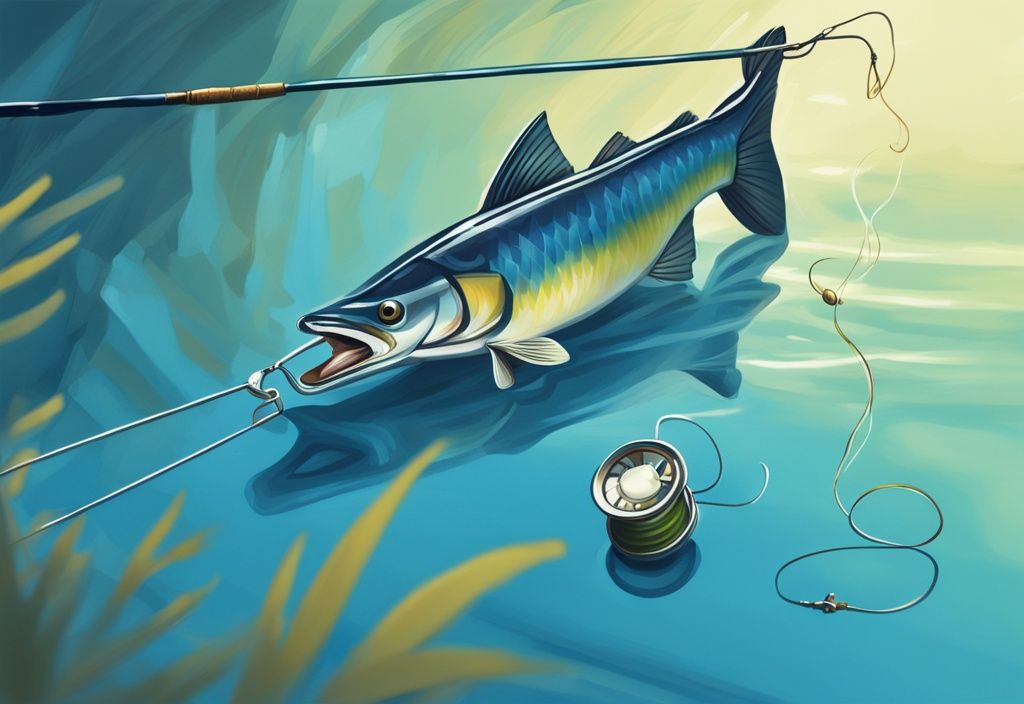
The Use of Swivels in Fishing Leaders
Swivels play a crucial role in connecting fishing leaders to the main line, especially when dealing with longer leaders or targeted species known to cause line twisting. Barrel swivels are a popular choice due to their effectiveness in preventing line twists that can compromise fishing efficiency. By placing a swivel between the main line and the leader, anglers can ensure smooth line behavior and avoid tangles.
This method is particularly useful for leaders longer than 4 feet, where maintaining line integrity and performance is critical. Swivels come in various sizes and strengths, allowing customization based on the fishing setup and targeted species.
Understanding and Using Leader Clips
Leader clips are essential tools for anglers looking to make quick changes and secure the leader to the main line efficiently. These clips provide a fast and effective way to switch leaders without needing to retie knots, which is particularly advantageous when experimenting with different leader materials or lengths during a fishing session. Various types of leader clips are available, each designed to cater to specific fishing setups and preferences.
For instance, quick-change clips allow for rapid leader swaps, while more robust clips offer enhanced security for targeting larger, more powerful fish. Utilizing leader clips not only saves time but also ensures that the connection between the main line and leader remains strong and reliable throughout the fishing experience.
Effective Fishing Techniques Utilizing Fishing Leaders
If you’re wondering what is a fishing leader and how it can improve your fishing success, then buckle up. This section dives into the ins and outs of using leaders for various fishing techniques that can transform your angling experience.
Fly Fishing with Leaders
Fly fishing with leaders is a game-changer for connecting the angler seamlessly with the lure or bait. Imagine casting out and watching as a well-chosen leader makes your lure flow naturally with the current; it’s almost poetic. Fish, often wary of unnatural presentations, are more likely to be enticed by a lure that glides effortlessly. A leader’s low visibility and its delicate handling of fly fishing intricacies make it indispensable. Acting like a buffer between your fly line and fly, leaders ensure your casts are smooth and precise. It’s this efficiency that turns a good day of fly fishing into a great one.
Bottom Fishing: Role of Leaders
In bottom fishing, fluorocarbon leaders are your best friend. Picture yourself navigating tough underwater terrains filled with rocks and corals; your leader needs to be robust, yet subtle. Fluorocarbon leaders shine here with their excellent abrasion resistance and low visibility, perfect for clear waters where fish spook easily. They can take a beating and keep your line—and your bait—intact. These leaders are tough enough to withstand the wear and tear from the underwater environment, making your bottom fishing setup both reliable and effective.
Leveraging Leaders in Topwater Fishing
Monofilament leaders rule the realm of topwater fishing. Think of a bright morning where your lure dances on the water surface, thanks to the floating property of monofilament. This material is fantastic for keeping your lure where it needs to be and absorbing the shocks from sudden fish strikes. Its stretchiness also lends a hand in imparting just the right action to your topwater lures, making them irresistible to fish. Monofilament leaders bring versatility and resilience to your topwater fishing game, making them an essential part of your angling arsenal.
Maintaining and Storing Your Fishing Leaders: Helpful Tips
Proper maintenance and storage of your fishing leaders are vital for ensuring their longevity and peak performance. Understanding what is a fishing leader and how to care for it can significantly enhance your fishing adventures. Here are some handy tips:
Store Out of Sunlight in a Cool, Dry Place
Exposure to direct sunlight can cause fishing leaders to degrade over time. Those pesky UV rays can weaken the material, making it less effective. Therefore, it’s wise to store your fishing leaders in a cool, dry place, shielded from sunlight. Think storage boxes or dark, climate-controlled areas. This way, you’ll not only extend the life of the leader, but also guarantee it’s in great shape when you need it most.
Regularly Check for Damage or Wear
Before each fishing trip, take a moment to examine your fishing leaders for any signs of damage or wear. Scan for nicks, abrasions, or discoloration along the length of the leader. This is especially crucial for fluorocarbon and monofilament leaders, which are prone to damage from abrasive surfaces or sharp objects over time. Regular inspections will help you catch and replace compromised leaders, maintaining your fishing efficacy and avoiding those dreaded break-offs mid-catch.
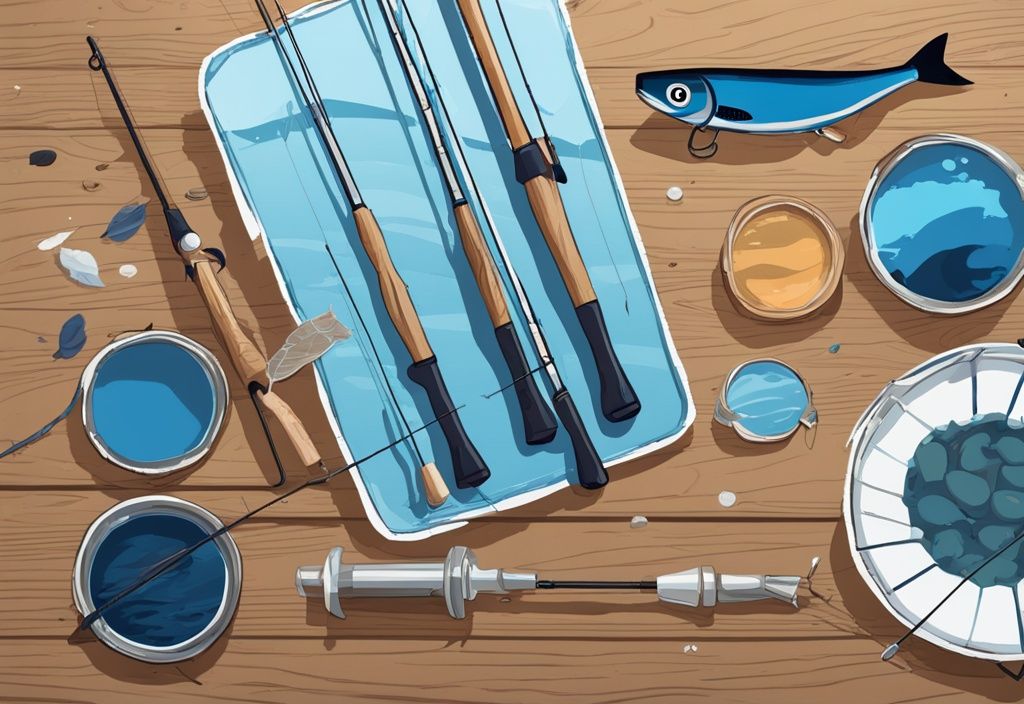
Replace Leaders as Necessary to Ensure Optimal Performance
Even the most pampered leaders will eventually bite the dust. Frequent use, braving the elements, and those epic battles with tough catches take their toll. It’s crucial to replace your leaders as soon as you spot significant wear or after a grueling fishing trip where the leader endured stress. Keeping spare leaders handy is a smart move, letting you switch to a fresh one when needed, ensuring a strong connection between your main line and your prized catch.
By following these tips, you can keep your fishing leaders in top-notch condition, ready to provide that extra abrasion resistance, optimal bait presentation, and low visibility needed for a successful fishing experience. Grasping what is a fishing leader and its pivotal role in your fishing setup underscores the importance of proper maintenance and storage.
FAQ
What are the notable benefits of using a fishing leader?
Using a fishing leader is like having a secret weapon in your tackle box. It offers extra abrasion resistance, which is crucial when you’re battling hefty fish or navigating rocky terrains. It also enhances bait or lure presentation, making your decoys more appealing to the fish. A leader reduces visibility in clear water, keeping those sharp-eyed fish from spotting your line. Plus, it shields against damage from structures, toothy creatures, and other underwater perils. Think of it as your fishing insurance policy.
How to select the best leader material for my needs?
Choosing the right leader material can feel like picking the perfect lure—critical yet confusing. Consider the species you’re after and the environment you’re fishing in. For instance, monofilament is versatile but visible, whereas fluorocarbon is nearly invisible underwater, ideal for clear conditions. Wire leaders come in handy when targeting toothy critters like pike or musky. Match your leader material to your needs for visibility, abrasion resistance, and flexibility, and you’ll be one step closer to that trophy catch.
What is the ideal length for my fishing leader?
When it comes to leader length, there’s a general rule of thumb: start with twice the length of your rod. This gives you a good balance of control and protection. But, like all things in fishing, it varies. If you’re targeting wary fish in clear water, a longer leader might be warranted. Conversely, shorter leaders work well in murkier conditions. So, assess your specific fishing scenario and adjust accordingly.
What are the effective ways to attach a leader to the main line?
Attaching a leader to the main line can be as simple or complex as you make it. The Albright knot is reliable and effective for most setups. If you’re dealing with long leaders, swivels can help prevent line twist. For those who love quick changes without compromising security, leader clips are your best friend. Experiment with these methods and find what works best for your setup, ensuring a secure connection every time.
How often should I replace my fishing leaders?
Inspecting and replacing your fishing leaders regularly is key to maintaining your setup’s performance. If you’re noticing frays, nicks, or any form of wear, it’s time to swap out the old leader for a new one. Frequent replacement may seem tedious, but it ensures your gear remains reliable, helping you avoid losing that big catch due to a weakened leader. Stay vigilant, and you’ll thank yourself later when you land that memorable fish.
Conclusion
In essence, a fishing leader is an extra piece of line that you attach to the end of your main fishing line. This simple addition offers critical benefits: it provides extra abrasion resistance, minimizes visibility, and ensures appropriate stiffness for presenting bait or lures effectively. Think of it as a buffer that shields your main line from harm caused by structures, sharp teeth, and various other potential hazards. This tiny adjustment can significantly enhance your overall fishing experience.
Choosing the right fishing leader material is a decision you shouldn’t take lightly. It largely depends on the species you’re targeting and the environmental conditions you’re dealing with. For example:
- Nylon monofilament: Versatile and easy to use, with moderate abrasion resistance.
- Fluorocarbon: More translucent and durable but can be a bit challenging to tie.
- Wire: Essential for toothy fish, though it might impact your bite rates.
Connecting fishing leaders to your main line can be done in several ways. You might prefer using knots like the Albright knot, or perhaps you lean towards using swivels and leader clips. These methods not only prevent line twists but also make it easy to switch out leaders quickly.
Maintaining and storing your fishing leaders properly is another essential aspect. Keep them out of sunlight and regularly check for any signs of wear and tear. This ensures they remain in optimal condition, ready for your next adventure.
Ultimately, fishing leaders play a pivotal role in upping your fishing game. They offer a more reliable and efficient setup, protect against environmental elements, and ensure that your bait or lure is presented in the most natural and attractive way possible. Understanding the components of your fishing gear, such as what a tippet in fly fishing is, can enhance your overall fishing experience. So next time you’re out on the water, you’ll feel more connected and ready to reel in that big catch.
